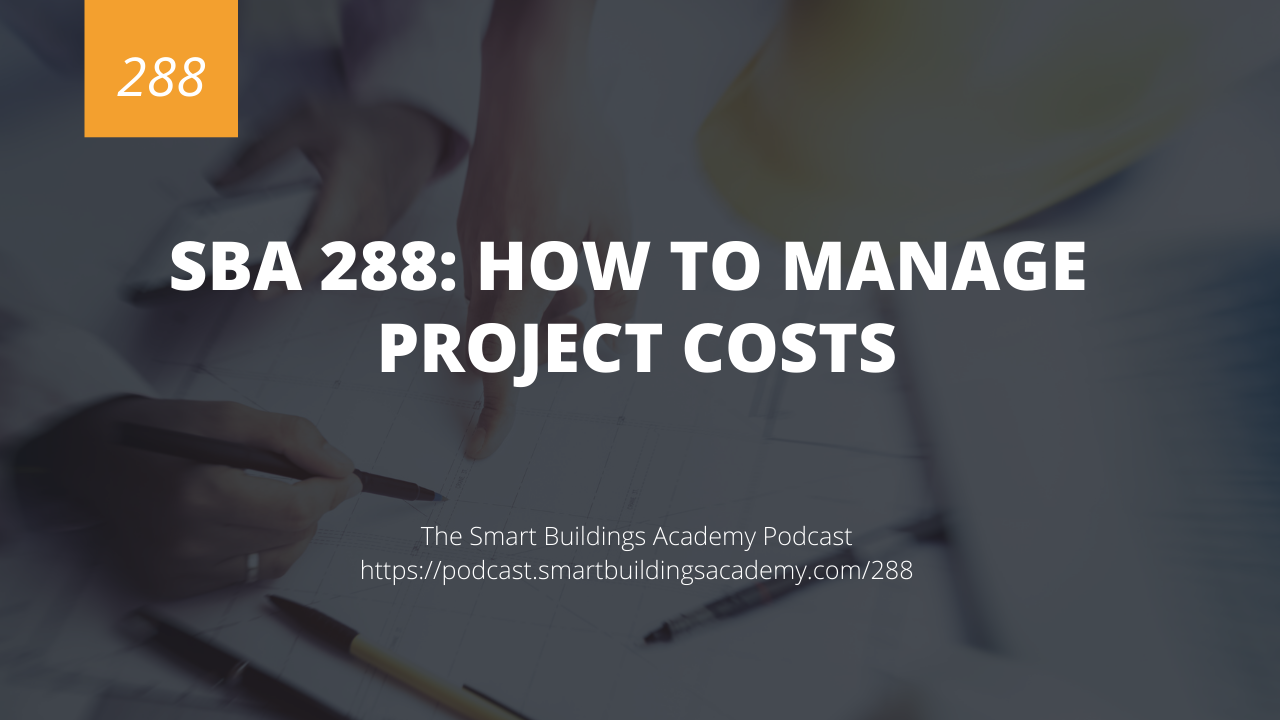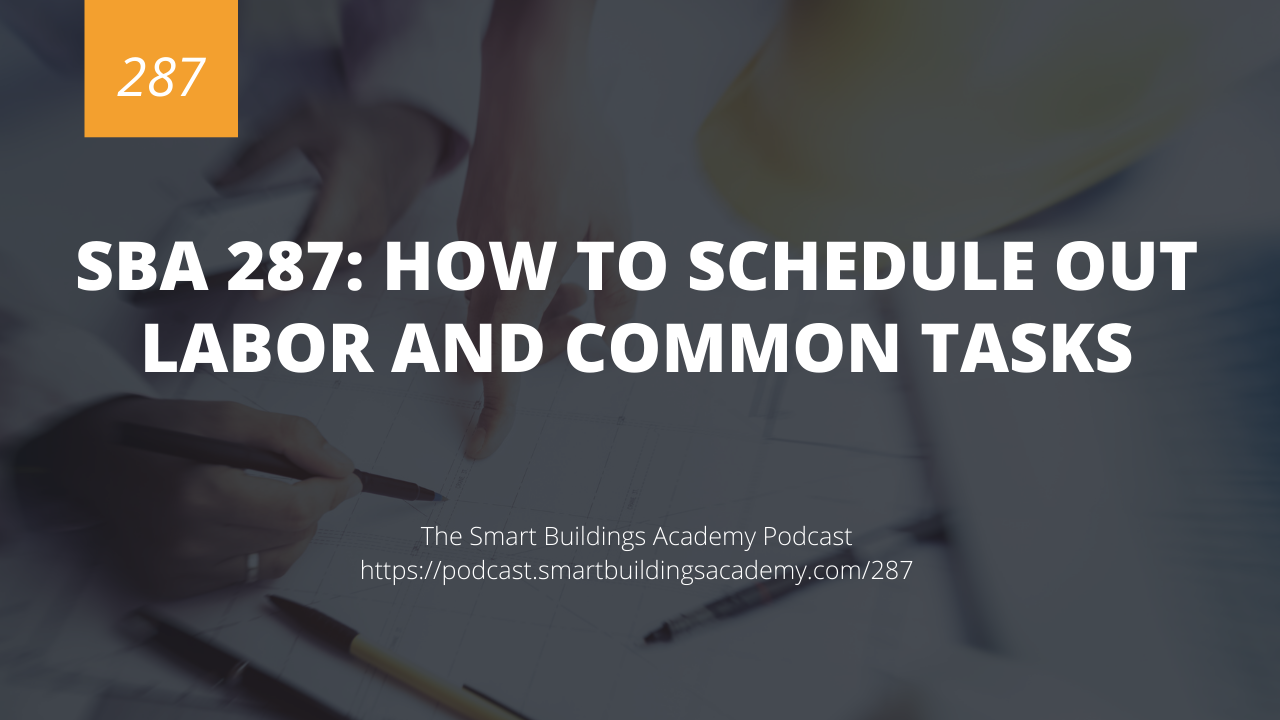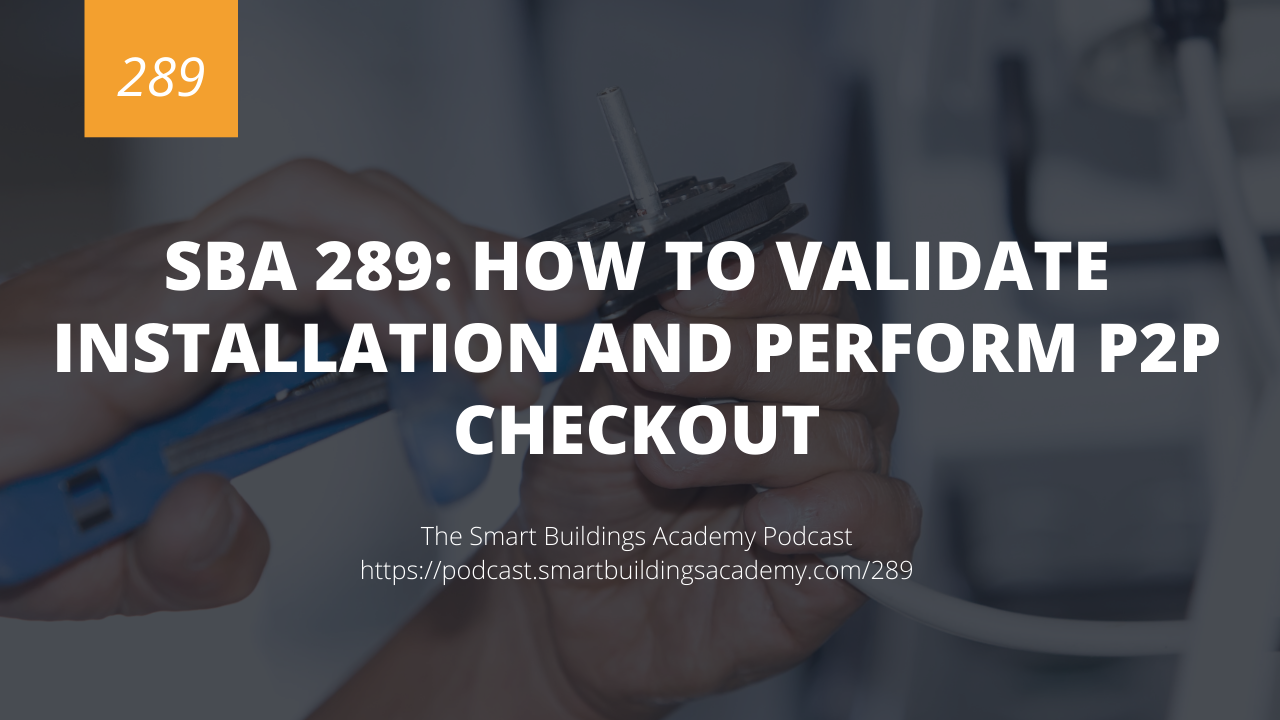In this episode we discuss how to manage project costs and strategies for cost reduction and cashflow in your building automation projects.
Click here to download or listen to this episode now.
Resources mentioned in this episode


Transcript
Phil Zito 0:00
This is the smart buildings Academy podcast with Phil Zito Episode 288 Hey folks, Phil Zito here and welcome to Episode 288 of the smart buildings Academy podcast and in this episode, we are going to be discussing how to manage project costs. Today's episode is sponsored by our project management bootcamp course if you are looking to learn more about project management, and you would like to learn how to run your building automation projects profitably and on time, then you definitely need to check out that course and you can find out more at podcasts smart buildings academy.com forward slash 288 once again that is podcast at smart buildings Academy comm Ford slash 288. Alright, so let's dive in to this thing called project costs. Okay, so if you think about it, up to this point, we've discussed the primary project costs, we just haven't went into a whole lot of detail from a cost management perspective. So to back up, there are three types of project costs, right? Three main buckets. And that's going to be labor material and subcontractors. Now whenever I teach this, I inevitably get people who point out but what about any bonds you need to do any permits, you need to do any travel fees, any things like that, so yes, there are miscellaneous charges. But the typical aspect of or the typical effect of miscellaneous charges is usually less than a percent on a job unless you're doing like a risk factor where I have seen risk factors get all the way up to 10%. And worst case scenarios, that's where you add an extra 10% of cost to projects due to risk. But if you do proper scoping, and you really do a proper takeoff, a proper re estimate, you should be able to negate any risk, or most risk rather. So now that we've got those three buckets of cost broken out, how do we manage cost, I'm going to talk through several different ways to manage cost. Now, not all of these are my preferred ways to manage cost, but just being real with you, they are ways that are used to manage costs. So for example, first cost we'll focus in is subcontractors. Now what typically happens with subcontractors, and we're talking about extra low voltage, you know, low voltage electrical subcontractors here, typically what's going to happen is we are going to get three prices for our subcontractors. So that's the first thing we're going to do. When a salesperson goes out, they should ideally be getting three prices for their electrical subcontractors. And picking either the lowest cost one or picking the one that best fits the job just depending on the circumstances and how competitive the bid is. Once that's done, though, during the re estimate, the project manager or the sales to operations hand off, either one, the project manager may, and I don't recommend you do this, but may go and shop at the subcontractors again to try to reduce prices even more. Now, this is something that, you know, I see a lot in the large OEMs that they train their project managers to do this because their project managers are incentivized by how much more profit they can bring into a project, you know, booked margin versus executed margin. If you increase executed margin, you get a percent and that's a bonus for you. And in my opinion, that is incentivizing a bad behavior. And here's why. Today, you absolutely cannot do that. And I know I will get emails from some people who will say, Well, I'm doing that right now. But on the macro level, you can't do that. There's just not enough supply of electrical subcontractors for you to get one to commit to your job and then start bidding them against each other. Once they've spent all that time, you're going to get a name for yourself, and people just aren't going to go after your work to kind of go after someone else's work. Because why would I give you my best price only to have you beat me up on price right after I gave you my best price. So that's their mindset. That's what they're thinking. And it's critically important that you take the time, as you recall, when we talked about doing our lining out our subcontractors in Episode 286. It's critically important that you take your time to establish these relationships with these subcontractors so that they can go and execute work according to your standards. And this is where a
Phil Zito 4:57
bidding strategy of bidding Your subcontractors against each other after already having bid them against one another can come back and bite you in the butt because no one's gonna want to establish a relationship with someone who's not trying to establish a relationship with them back. So just be cognizant of that from a costing perspective. Additionally, from a costing perspective, and this is going to be across labor or material and subcontractors not across labor, look for favorable payment terms. Now, once again, this is something that taking to the extreme, can actually be very detrimental to yourself, but look for, you know, paid one paid, ideally. So that means you don't have to pay out to your subs or to your materials until you've been paid. So look for that in your terms, if you can, some of you will be able to do that, based on the size of your company, others will not also look for terms like you know, net 60, or net 90, etc, which then means that you collect the money for your bills, but you don't have to pay or the bills that are owed to you, you collect the money for. But the bills you owe on you don't have to pay for 6090 days, that means you're working off of other people's money, and you're having positive cash flow because you've got more money coming in than you have going out. And ideally, that's how we want to manage our projects is more money coming in than we have going out. Now the downside to this, of course, is it takes advantage, in my opinion of your material suppliers and your subcontractors. I personally am a fan of net 30. At the longest terms, I think going longer than that you're basically working off of other people's money without interest. And I don't feel like that's right. I am not naive in that, I realized the business world operates based off of primarily a sense of profit, not necessarily a sense of right and wrong. But I just don't feel right if I've been paid and I have the money. Not paying my subcontractors often who are much smaller companies than me are not paying my material providers who often are at very tight margins themselves, and not paying them. It just doesn't feel right. But you know, like I said, it is a strategy to make sure that your costs are being delayed against you, and you're working off of other people's money, which makes your projects profitable, it makes things look nice. Now, you really can't do that with labor. Unfortunately, with labor, you're fairly limited because you have to pay out paychecks. So your strategy with labor is really looking at what is you can either take two approaches, you can do the lowest skill that I can do for the highest task. And what I mean by that is, if you're able to have someone who's a technician, who you're paying, you know, 40 bucks an hour, do some programming, which normally you pay your programmers at 90 an hour, then you're saving 40 to $50 an hour on all of that labor, even if that person's like 10% less efficient, you're still making money on long net long run. So one school of thought is to try to use the cheapest labor for the most tasks. And that's one way to do things. The other is the inverse, which is using the more expensive labor for tasks with the theory that if this is a task that can be completed easier with this more expensive labor, then you're going to make up your money in efficiencies. So you want to aim for efficiency instead of just Hey, accepting inefficiency with the lower end labor. Now what would this look like actually played out in a practical example? Well, if you had 1000 v v boxes, even if you had someone who was semi unskilled and brand new, you train them on one to two v v boxes and then by the time they're at the 100th v v box, they should be extremely efficient at both programming graphics, everything so you can start to turn over a ton of stuff to them and they will do it efficiently
Phil Zito 9:23
there may be a little inefficiency in the beginning but by the time they get to the you know 500 va v box they are going to be really efficient at the graphics, the uploading, the downloading the programming, the point the point, check out the functional test, etc. It's when you have smaller projects that are very complex or have complexities to them that I tend to like to use a more senior person in the senior person, although you're paying a lot to have them do point to point they're checking out the entire system. Like if you have a central utility plant with a decoupler and it's you know, got a differential pressure sensor on a nother controller on the other side of the campus. And just it's a messy program, having someone actually who's very experienced work on that, in my opinion will pay off even though you're paying more, you're going to spend less time and you're not going to have to go back and check it out again. So it's a balance, right? It's a balance with your labor as to where you go and apply. Cuz I will tell you, most people don't even have that delineation, they just have a blended Labor Rate and whoever goes goes, but if you're following what I've taught earlier, which is to have a labor breakout by task, then what's going to happen is that labor breakout by task is going to give you the ability to allocate costs, according to what tasks should be executed, and you can really start to see the efficiencies of your projects. So up to this point, we talked about subcontractors, we talked about our tasks, and our costs related to labor. Now let's talk about material. materials, something really nice. One of the first things we're going to do on our projects, as I mentioned is submittals. And as soon as we get submittals going, then we can get material on order typically. And the nice thing about getting material on order is that by having material on order, what's going to happen is we are now going to be able to build for that material. Typically on a project, sometimes it has to actually be on site for us to be able to Bill, sometimes it simply has to be on order. But that gives us the ability to bill, which when we're able to bill now we're able to kind of play that game that I mentioned of, okay, we've build, we've received revenue, we're going to do paid one paid plus net 60. And we're going to work off of that revenue, if it's large enough to fund maybe our labor to fund maybe, or subcontractor cost. But basically, funding costs until we get a steady cash flow flowing in, so that we don't have to worry about having negative cash flow in a project. At the end of the day, it's all about getting positive cash flow into the project is about getting more cash flowing into the project that we have flowing out of the project. So that the project itself is self funding. That is how you build a large business. If those of you who are like how do I scale my building automation business? How do I take it from 5 million to 10 million, or from 10 million to 20 30 million? You do it by having your projects be profitable, because what happens if your projects are profitable, then that means that they are self funding, right? Well, I should be clear, you have it so that your projects are self funding, and profitable, because those are two really separate things, you can have a project that is not self funding the entire way, but ends up being profitable at the very end, but you want a project that is self funding so that your general capital can be being invested into other things like hiring more sales, people, expanding territories, etc. And then you want your projects to be profitable, because then you can take that excess profit at the end of the project. And you can apply it back to the general fund for your business, so that your business can then go and continue to expand. So that's kind of the trick there right is you get your projects, you get your projects profitable, you get them to also be self funding. And the self funding reduces your overall capital burden on your companies so your company can expand so it can hire new people. And then the fact that it's profitable grows that capital fund by taking the profit out of the projects and allocating it to the capital fund at the end of the project. Alright, so
Phil Zito 14:00
this was a shorter episode. In our next episode, we're going to talk about how to validate installation and perform Point to Point checkout that will be a longer episode. And I hope you all enjoyed this. If you have any questions at all related to project costs, do not hesitate to reach out. I encourage you to reach out to us we'd love to answer those questions for you. And if you really want to get down to the brass tacks with your project management and you want to get your project management skills or maybe your project management team up to speed, I encourage you to check out our VA s project management bootcamp course, which will teach you exactly what you need to know to succeed in building automation project management. You can find out more about that at podcast at smart buildings academy.com forward slash 288 once again this podcast at smart buildings Academy comm forward slash 288 Thanks a ton and take care





